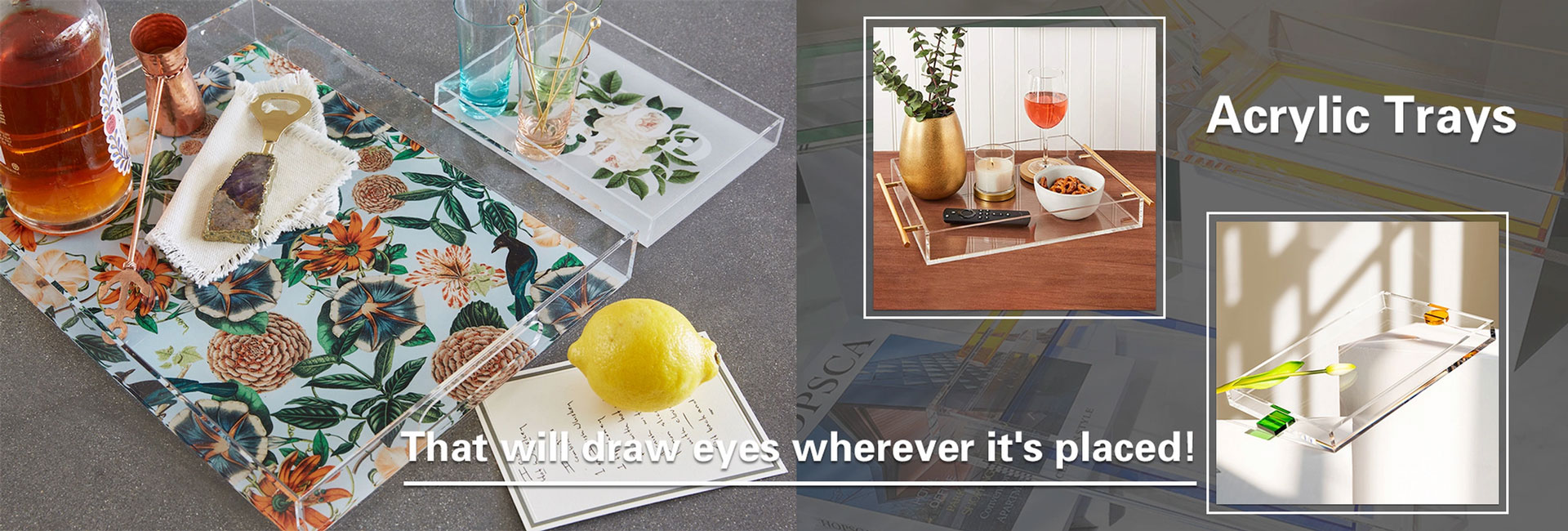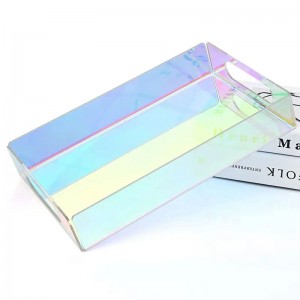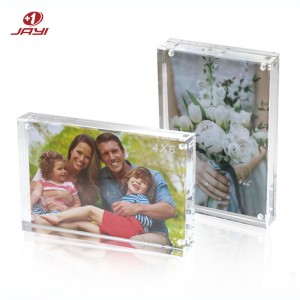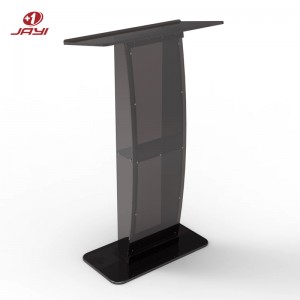
Acrylic trays have become a staple in both residential and commercial spaces, thanks to their sleek appearance, durability, and versatility. Whether you’re using them for serving drinks, organizing office supplies, or displaying products in a retail setting, custom acrylic trays offer a tailored solution that fits your exact needs.
However, navigating the world of custom sizes and specifications can be overwhelming without the right guidance. In this comprehensive guide, we’ll break down everything you need to know about custom acrylic tray dimensions, material thickness, edge finishes, and more, helping you make informed decisions for your project.
Understanding Standard vs. Custom Acrylic Tray Sizes
Before diving into custom options, it’s helpful to familiarize yourself with standard acrylic tray sizes, as they often serve as a starting point for customization. Standard trays typically range from small, compact designs to larger, multi-purpose ones:
Small Acrylic Trays:
Sized 6x8 to 10x12 inches, they are perfect for jewelry, keys, or condiments.
Compact yet functional, they fit neatly on dressers, entryway tables, or dining counters.
Their small size keeps tiny items organized without taking up much space, blending utility with a sleek look for both home and small commercial setups.
Medium Acrylic Trays:
Ranging from 12x16 to 16x20 inches, they are ideal for serving coffee, tea, or snacks.
Their size strikes a balance—roomy enough for mugs, plates, or small bowls, yet compact enough for easy handling.
Great for home use, cafes, or events, they blend functionality with style, keeping items organized while adding a polished touch to any setting.
Large Acrylic Trays:
At 18x24 inches or larger, excel at serving meals, showcasing products, or organizing bigger items.
Spacious enough for dinner plates, retail displays, or tools, they balance functionality and strength.
Ideal for restaurants, stores, or workshops, their size handles bulk without sacrificing usability, adding practicality to commercial and home settings alike.
While standard sizes work for many scenarios, custom acrylic trays shine when you have specific requirements. For example, a restaurant might need a tray that fits perfectly into a built-in shelf, or a business might want a tray with unique dimensions to showcase a signature product. Custom sizes allow you to maximize space efficiency, align with branding, or meet functional needs that standard trays can’t address.
Key Factors to Consider When Choosing Custom Tray Sizes
When determining the size of your custom acrylic tray, several factors come into play. Let’s explore the most critical ones:
Purpose and Functionality:
The primary use of the acrylic tray will dictate its size.
A lucite tray for serving cocktails at a bar will be smaller than one used to transport dishes in a restaurant kitchen.
Similarly, a tray for organizing tools in a workshop needs to accommodate specific tool sizes, while a vanity tray for cosmetics should fit neatly on a bathroom counter.
Space Constraints:
Measure the space where the acrylic tray will be used or stored.
A tray that’s too large won’t fit on a shelf, while one that’s too small might not serve its purpose.
For example, if you’re designing a tray to fit inside a drawer, precise measurements of the drawer’s length, width, and depth are essential.
Weight Capacity:
Acrylic is a durable material, but its weight capacity depends on thickness and size.
Larger acrylic trays may require thicker acrylic to prevent bending or warping, especially if they’ll hold heavy items.
For instance, a tray used to hold books or electronics will need to be sturdier than one used for lightweight jewelry.
Acrylic Trays Thickness: Finding the Right Balance
Acrylic thickness is measured in millimeters (mm) or inches, and it plays a crucial role in the tray’s durability, appearance, and functionality. Common thickness options for acrylic trays include:

2-3 mm:
2-3 mm acrylic trays are thin, lightweight, and flexible, ideal for decorative use or holding very light items like jewelry or small trinkets.
Their delicate build adds elegance to displays but limits durability—they’re not suited for heavy use or carrying weight, as they may bend or warp under pressure.
Perfect for adding a subtle, stylish touch to home decor.
4-6 mm:
4-6 mm acrylic trays strike a perfect balance between durability and weight, making them highly versatile.
Ideal for standard use, they work great as serving trays, vanity organizers, or storage solutions.
Sturdy enough to handle daily use without being bulky, they blend functionality with a sleek look, fitting seamlessly into both home and commercial settings.
8-10 mm:
8-10 mm acrylic trays are thick, rigid, and built for heavy-duty use.
Resistant to bending, they easily hold heavier items like tools, dishes, or electronics.
Their sturdiness makes them ideal for workshops, restaurants, or garages, balancing durability with functionality for demanding daily use.
When choosing thickness, consider the tray’s size. A large tray with a thin thickness is more likely to sag under weight, while a small tray with excessive thickness may be unnecessarily heavy.
Edge Finishes: Enhancing Aesthetics and Safety
The edge finish of an acrylic tray affects both its appearance and safety. Sharp edges can be a hazard, especially in trays used around children or in high-traffic areas. Here are common edge finishes to consider:
Polished Edges
Polished edges bring a smooth, glossy finish to acrylic trays, delivering a sleek and professional appearance.
Safe to the touch, they reflect light beautifully, boosting the tray’s visual allure.
This finish is a top pick for decorative trays that adorn spaces and serving trays used in cafes or homes, as it adds a refined touch to any setting.
Flame-Polished Edges
Flame-polished edges are crafted by gently melting the acrylic edge with a flame, resulting in a smooth, rounded look.
This method is budget-friendly, making it a practical choice.
It works wonderfully for trays where a subtle, clean edge is preferred, blending functionality with a neat finish without compromising on aesthetics, suitable for both casual and semi-formal uses.
Rounded Edges
Rounded edges are created through sanding, forming a curved shape that eliminates sharp corners.
This makes them ideal for trays used in homes, especially with kids, and restaurants.
They significantly reduce the risk of injury, ensuring safety in busy environments. The soft curve adds a gentle look, complementing various decors while prioritizing practicality.
Beveled Edges
Beveled edges feature an angled design that infuses acrylic trays with elegance.
They’re a hallmark of high-end trays, perfect for luxury retail displays showcasing premium products or upscale events like galas.
The angled cut catches light uniquely, enhancing the tray’s sophisticated appeal, making it a statement piece in refined settings.
Choosing a Reputable Acrylic Tray Manufacturer
To ensure your custom acrylic tray meets your specifications, it’s essential to work with a reputable manufacturer. Here are tips for selecting the right one:
Experience and Expertise
Prioritize manufacturers with a solid history in custom acrylic products.
Scrutinize their reviews to gauge client satisfaction, peruse portfolios to assess craftsmanship, and check testimonials for real-world performance.
An experienced maker understands nuances like material behavior and precision cutting, ensuring your tray meets exact specs reliably.
Material Quality
Insist on manufacturers using high-grade acrylic.
Inferior materials are brittle, prone to yellowing over time, and lack clarity, ruining both function and aesthetics.
Premium acrylic retains transparency, resists cracks, and withstands daily use, ensuring your tray stays durable and visually appealing for years, justifying the investment.
Customization Options
Opt for manufacturers offering diverse customization: flexible sizes, varied thicknesses, multiple edge finishes, and extra features like handles or engraving.
This ensures your tray aligns perfectly with unique needs, whether it’s a branded retail display or a tailored organizational tool, avoiding compromises on functionality or design.
Turnaround Time
Always ask about production and delivery timelines upfront.
A manufacturer with clear, reliable schedules ensures your tray arrives when needed, critical for events, business launches, or personal projects.
Delays can disrupt plans, so prioritize those with a track record of meeting deadlines without sacrificing quality.
Pricing
Compare quotes from multiple manufacturers, but don’t fixate solely on the lowest price.
Quality should take precedence: better materials and skilled craftsmanship often come with a slightly higher cost but result in a more durable, attractive tray. Skimping on price may lead to frequent replacements, costing more long term.
Jayiacrylic: Your Leading China Custom Acrylic Tray Manufacturer
Jayi acrylic is a professional acrylic tray manufacturer in China. Jayi’s acrylic tray solutions are crafted to enthrall customers and present both functionality and aesthetics in the most alluring way. Our factory holds ISO9001 and SEDEX certifications, guaranteeing top-notch quality and ethical manufacturing practices. With more than 20 years of experience partnering with leading brands, we fully grasp the significance of designing acrylic trays that meet diverse usage needs and enhance user experience.
Conclusion
Custom acrylic trays offer endless possibilities for both personal and commercial use, with sizes, thicknesses, and features tailored to your exact needs. By considering factors like purpose, space constraints, thickness, and edge finishes, you can design a tray that’s both functional and visually appealing. Whether you’re a business owner looking to brand your space or a homeowner seeking an organized, stylish solution, a custom acrylic tray is a versatile investment that combines durability and elegance.
Remember, the key to a successful custom acrylic tray project is clear communication with your manufacturer. Provide detailed specifications, including size, thickness, edge finish, and any additional features, to ensure the final product meets your expectations. With the right design and execution, your custom acrylic tray will serve you well for years to come.
FAQ: Common Questions About Custom Acrylic Trays

What’s the Difference Between Standard and Custom Acrylic Tray Sizes?
Standard sizes (e.g., 6x8 inches to 18x24 inches+) work for general use, while custom sizes are tailored to specific needs. Custom trays fit unique spaces, align with branding, or accommodate special items—like a tray for a built-in shelf or to showcase a signature product—offering flexibility that standard sizes lack.
How Do I Choose the Right Acrylic Thickness for My Tray?
Consider the tray’s size and intended use. 1-3mm is for light, decorative use; 4-6mm balances durability and weight for most trays; 8-12mm suits heavy-duty needs. Larger trays need thicker acrylic to avoid bending, while small trays with excessive thickness may be unnecessarily heavy.
Can I Add Custom Features like Handles or Dividers to My Acrylic Tray?
Yes, many manufacturers offer custom features. Handles (acrylic, metal, or wood) improve portability; dividers create compartments for organization; cutouts add functionality (e.g., cup holders) or branding. Printing/engraving can also add logos or designs for personalization.
How Do I Maintain My Custom Acrylic Tray to Keep It in Good Condition?
Clean with mild soap and water using a soft cloth; avoid harsh chemicals. Keep away from extreme temperatures to prevent warping. Use felt pads to prevent scratches, and store in a cool, dry place without heavy items stacked on top to avoid bending.
What Should I Look for in a Reputable Acrylic Tray Manufacturer?
Prioritize experience (check reviews/portfolios), high-quality acrylic (avoids brittleness/yellowing), diverse customization (sizes, finishes, features), reliable turnaround times, and fair pricing—with quality over cost, as better materials/craftsmanship last longer.
You Might Also Like Other Custom Acrylic Products
Post time: Aug-05-2025
















